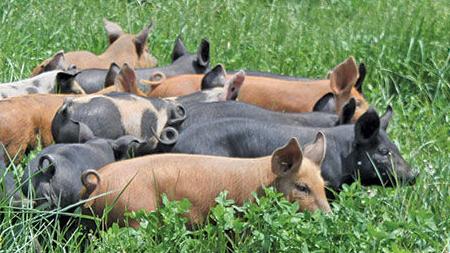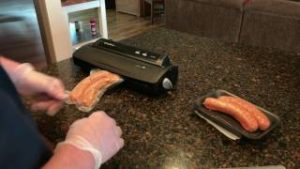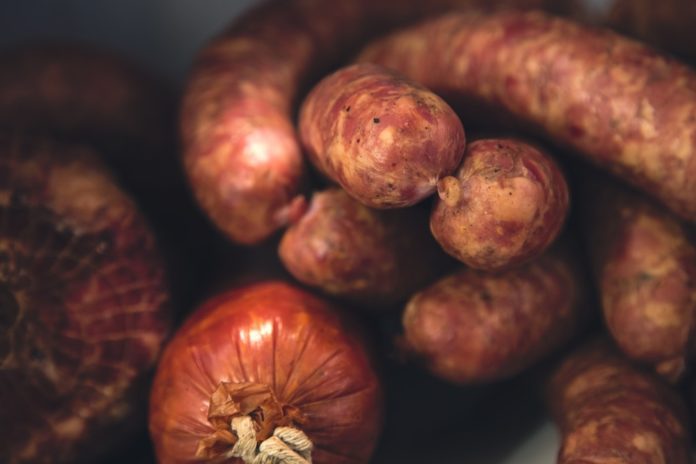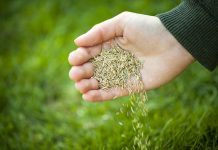Making and smoking your own sausage at home is an art in itself. There is nothing like it but it does take some patience and the ability to keep up with the process.
Meat safety should always be a concern
Some types of meat have different safety issues than others. There is a variety of foodborne nasties that you have to watch out for. It is not hard to avoid all of this if you just follow some basic rules.
1. Make sausage from the freshest meat possible.
For the sake of quality, it pays to get the freshest meat you can. Grocery store meats sometimes have been frozen and unfrozen several times before they make it to you. If possible get your meat directly from a farm or butcher. Direct from farm and buying in bulk is usually the best deal for your money.


The stock stands were hotels, trading posts, restaurants, and more! These stands would feed your hogs and stock for a fee that was either paid in a trade or you would pay on your way back through after selling the hogs. Plenty of corn farmers’ livelihood was made selling to the stands. Sometimes 50;000 hogs were on the road during the drives with many different drovers and drivers.
I like the stories of the Drover’s Roads and how commerce worked here for our families years ago. I tell this story because it really meant something to us to be able to get a start putting meat on the table from our own land and make a little money selling piglets and trading. We were living in a camper with no indoor plumbing but a little power from an extension cord.
2. Buy more casings then you think you will need.
Hey, there is a learning curve to all this. Hopefully, you can read this and avoid some of the mistakes I made when starting off curing meats in my 20s! It is far better to have more casings than you need than too few.
Fat Versus Lean Protein
You are making sausage. This means you need to get over any fear of fat you have. Not all fats are bad for you contrary to what it may seem like if reading a lot of health articles.
In order for the sausage to turn out alright, there has to be some fat in there. With really lean meats you may want to add some fat. Grassfed beef and pork can be pretty lean even though it tastes delicious.
Adding some pork fat or extra beef fat in the mix can help out a lot. Given the choice, most people like to add some pork fat in the mix.
Related: How to Make 10 Types of Survival Bread
Consistent sizes
Larger casings take longer. Some people find keeping up with different sizes during the smoking process while others are not.
If you choose to smoke ½ lb cased sausages at the same time as 1 lb; at least try to group them together by size within your smoker. If you are doing a lot it is probably better to do one batch of each size.
Spices
Oh boy – this is a big subject. Everyone has their idea of what is the perfect spice blend. I will gladly give you examples and I hope you like and enjoy them but I also think you might want to customize them to your own tastes.
This is most true when it comes down to your old basic salt and pepper! These two flavor profiles are the main deal when it comes to sausage flavoring. The saltiness and the right amount of heat are where it’s at.
The other flavors and spices are important but any sausage that others want to come back for seconds has to have the right balance of salt and heat.
Supply List
There is a lot to cover here so I want to take a minute just to have a summary list of supplies you will need
- Meat & Fat (75% lean meat 25% fat) If meat is lean you can add some pork or beef fat to change the ratio to what it should be
- Casings- 1 lb size is traditional for summer sausage
- Prauge Powder #1 or “Pink Salt”. The #1 is for quick curing and what you want for sausage.
- Bacto Ferm Lactic Acid Culture. A little goes a long way so while packets may seem costly for a little powder; you can seal it back up for your next batch or use a little more to ensure proper colonization to prevent botulism. There are good instructions on the packet.
- Meat Grinder
- Sausage Stuffer
- Smoking woods. Oak, Hickory, and Apple are particularly good. Avoid using any Pine, Hemlock, etc.
- Wood should be seasoned and dry. No greenwood!
If you are using a propane-powered smoker then you will just need wood chips for adding flavor during the smoking process. Brush up on how to use your smoker if you have not in a while.
Fermented Sausages Versus Just Smoked
Summer sausage and salamis are fermented sausages. This means that you have to allow a lot of extra time and allow the meat to be totally fermented before stuffing and smoking.
This also means mixing the meat a few times a day until you reach the fermentation level required. You can buy the starter cultures easily enough but they really are something you have to order unless you have an exceptional kitchen supply store or similar.
This is not a style of sausage that a lot of people do but it sure is good and worthwhile! No more $10 per lb summer sausage buying for your next picnic.
The Magic Ratio Of Fat to Lean
75% Lean and 25% fat was long the standard for making sausage but those in the modern world sometimes prefer a leaner ratio of 85% lean to 15% fat.
I don’t advise going leaner than that or you risk your sausage being too dry and falling apart after smoking instead of having the rich and succulent texture you are accustomed to when buying your own cured sausage at the store.
Grinding your own whole fresh meat is advisable unless you can be assured that the meat you buy ground up has not been kept in the ground state and not frozen for an extended period of time. Quality can start to deteriorate rapidly if meat is not processed in a timely manner.
Meat Grinders and Sausage Stuffers
There is a lot of different types of grinders and stuffers out there. I will say that if you plan on doing this a lot then do not buy a cheap grinder and stuffer. You will regret it very much and probably break it. When you are trying to grind up a whole animal you will be thankful you invested in the right tool for the job.
If you have one of the classic Kitchen Aid Mixers you can get a meat grinder attachment. This is good for small jobs and since you are using a Kitchen Aid motor you are going to be doing a lot better than a cheapo $60 all in one unit.
Hand grinders work and I have definitely used them to grind up an lb or two of burger here and there when we butchered our first cow but it is a lot of work and pretty darn impractical for big jobs.
I remember that the burger seemed really good though and feeling accomplished that we had managed that back in our 20s and living in that old 1978 Holiday Rambler with a brown tarp over it.
Casings
Like I said before, casings are important. The way you handle your casings depends on the variety you choose to use. Most of them need to be soaked in warm water before use. This helps with flexibility when stuffing them.
Double-check the instructions with your casings and handle accordingly. Soak times are often 30 minutes or so before stuffing so plan ahead a bit.
Smaller casings smoke more quickly than larger ones and are often more practical.½ to 1 lb of sausage is a good rule of thumb if you are not doing small link sausages like regular breakfast sausage.
Tying casings
Casings, after they are filled, are either closed with a metal ring and pliers or you have to tie them off with butchers twine.
A batch of summer sausage in our homemade smoker/oven. We gathered up fieldstone around here and built this smoker. It has served us well over the years.
The Importance of Prauge Powder
The temperatures and timing of smoking can create an environment where botulism can thrive but this can be prevented with some simple and cheap methods.
Using nitrates can completely prevent this from happening. Use ½ tsp Prauge Powder #1 per 2.5 lbs of meat. This will need to be mixed in with ground meat and the meat allowed to set in your refrigerator overnight to ensure that the nitrates have enough time to thoroughly penetrate the meat and treat it.
If sausage is very finely ground just letting it set in the fridge for just a few hours is enough. Course ground sausage definitely needs overnight time. Nitrates and nitrites like those found in Prauge Powder sometimes get a bad reputation.
The truth is that they are naturally occurring in some foods like celery powder which is what is used in all the sausages that claim to be naturally cured with no added nitrites. This is misleading because they are there they are just from a more natural source!
Make sure you set aside adequate time for smoking and have all your supplies on hand.
Smoking is not for the impatient. You need to allow 3-6 hours of smoke time for sausages depending on what you are doing. This doesn’t include any other prep time.
Related: How to Make Your Own Solar Stove
Vacuum sealing


Sausages can be vacuum sealed and frozen for long term storage. Make sure sausage has been dunked in chilled water after being removed from the smoker and then completely cooled before vacuum sealing.
Even fermented sausages that are shelf-stable should be packaged well. This may mean just vacuum sealing.
Sausage will keep indefinitely in the freezer if not allowed to freezer burn. Fermented sausages that are dry cured to be shelf-stable have varying shelf lives that will depend somewhat on the storage conditions you subject them to.
I don’t recommend unthawing summer sausage out until you want to eat it. If you unthaw it and leave it in the bag it can get moisture on the outside of the casing that can be trapped and it seems to spoil the sausage faster.
Summary Of Procedure
I have tried to cover a lot of ground here and hope it has not been too confusing but I think it is worthwhile to summarize the sausage-making procedure.
- Using a large food-grade container mix ground meat, Prauge Powder, and Bacto Ferm as directed on the packages you purchased. Add spices as desired.
- Allow meat to ferment. This may take a few days. You should mix it up a few times to make sure the culture and Prauge Powder have thoroughly penetrated the meat and treated it. Meat that is fermented will be a bit brown looking whereas the stuff that is still working is pinker. The brown color becomes a nicer pink color when you smoke it.
- Prepare casings and stuff sausages. Tie off the end with butchers twine or use a metal ring.
- Add to the prepared smoking chamber. To start off you want your smoking chamber to be 140 degrees, F. Smoke, at this temp for 2 hrs and then raise temperature to 160 degrees F and smoke for another 2 hours. After this, you can raise the temp to as high as 175 degrees F until sausages achieve an internal temperature of 155 degrees Fahrenheit.
- Carefully remove sausages and dunk in ice water. This stops them from cooking. When totally cool you can package them as desired. If you are tired you can do this the next day but stick them in the fridge.
Smoking Tips
Some people have slightly different guidelines for smoking sausages. The important thing to remember is not to let the temperature drop below 140 degrees F and to cook until 155 degrees F is reached internally.
Make sure to check sausages that are located in different areas of your smoker. Sometimes they do not cook evenly; especially in homemade ones and you want to be sure they are safely cooked.
Smoking Fires and Alternatives
It can take a while to get a good smoking fire going. If you are going the old fashioned route and not using an electric smoker then you need to allow ample time.
Have all your wood split to the small size the day before if you can. You want your fire to be down to coals before smoking begins.
You really have to monitor your fire throughout the day. Smoking the old fashioned way is not for someone that wants to run around town half of that day. Don’t smoke meats on days when you are not going to be able to stay at home the whole day and make sure it is done right.
We just make sure to take care of other things around our place on smoking days or just have a beer and smoke some food!
If you feel that you cannot watch a fire that well then there are plenty of electric or propane smokers out there. The propane ones are kind of neat because you can just set them up anywhere and a lot of them will smoke a lot of meat at once.
People get really good results with them. Fire is not a practical choice for a lot of people and during dry spells, you may not want to burn even a small one.
Sausages Make Good Gifts
Who doesn’t have fond memories of the food baskets and gifts that you get at the holidays? People love to get homemade gifts and giving them your own smoked sausages is a gift you can be proud of!
Have you cured and smoked your own sausages? Do you have seasoning recipes to share? We would love to hear your methods and tips! There are just so many great ways to season!
Years ago we were given a copy of Warren R. Anderson’s “
There are detailed smoking temps; times; tables; and a wealth of info. If you want to cure and smoke foods I recommend getting this book. Warren even shows you how to make your own smokers.
Spices and Seasonings
There could be an entire full-length book written about sausage spicing recipes. The truth is that everyone has their preferences. I am not going to tell you exactly how to spice your sausage.
I think exploring some books and sausage making websites can help you get a good idea. If this is your first time and you like a traditionally flavored summer sausage than you may want to start out buying a premixed sausage seasoning and using it as directed. After this you may have a better idea of how you might adjust flavors for your needs.
Sausage Maker Seasoning
One Jar = 50 lbs of seasoned sausage
Note: You still need to add Prauge Powder #1 and Bacto Ferm culture. This is just seasoning.
You can always measure and season a little meat and fry it up and taste it. It won’t have the smoke flavor but you can get an idea of what the seasonings offer and add more or less.





















